Monumento a Alfonso XII
The Monumento a Alfonso XII, or the Monument to Alfonso XII, is an imposing and majestic monument located at the edge of the beautiful Retiro Park in Madrid. This monument is not only a tribute to King Alfonso XII of Spain but also an iconic symbol of the city and a popular tourist attraction.
The monument was built in honor of King Alfonso XII, who reigned from 1874 to 1885 and played a significant role in modernizing Spain. It was erected as a national tribute to his reign and his contributions to the politics, economy, and culture of Spain.
The design of the monument is the result of an international competition held in 1902. The winning design was submitted by architect José Grases Riera, who worked with various sculptors and artists to bring the monument to life. Construction began in 1902 and was completed in 1922, but the monument was officially inaugurated in 1928.
The Monumento a Alfonso XII is a masterpiece of neoclassical architecture and sculpture. It consists of a grand semicircular colonnade, crowned with a large dome supported by elegant columns. At the base of the monument lies a large basin with fountains, surrounded by terraces and gardens that offer a beautiful view of the Retiro Park’s lake.
The most striking feature of the monument is the equestrian statue of King Alfonso XII, proudly positioned on a raised platform at the front of the colonnade. The statue is a work of art and an impressive reminder of Spain’s royal heritage.
In addition to the statue of King Alfonso XII, the monument includes numerous other sculptures and reliefs that highlight various aspects of Spanish history and culture. These feature depictions of historical figures, allegorical representations, and mythological scenes that reflect the grandeur and diversity of the Spanish nation.
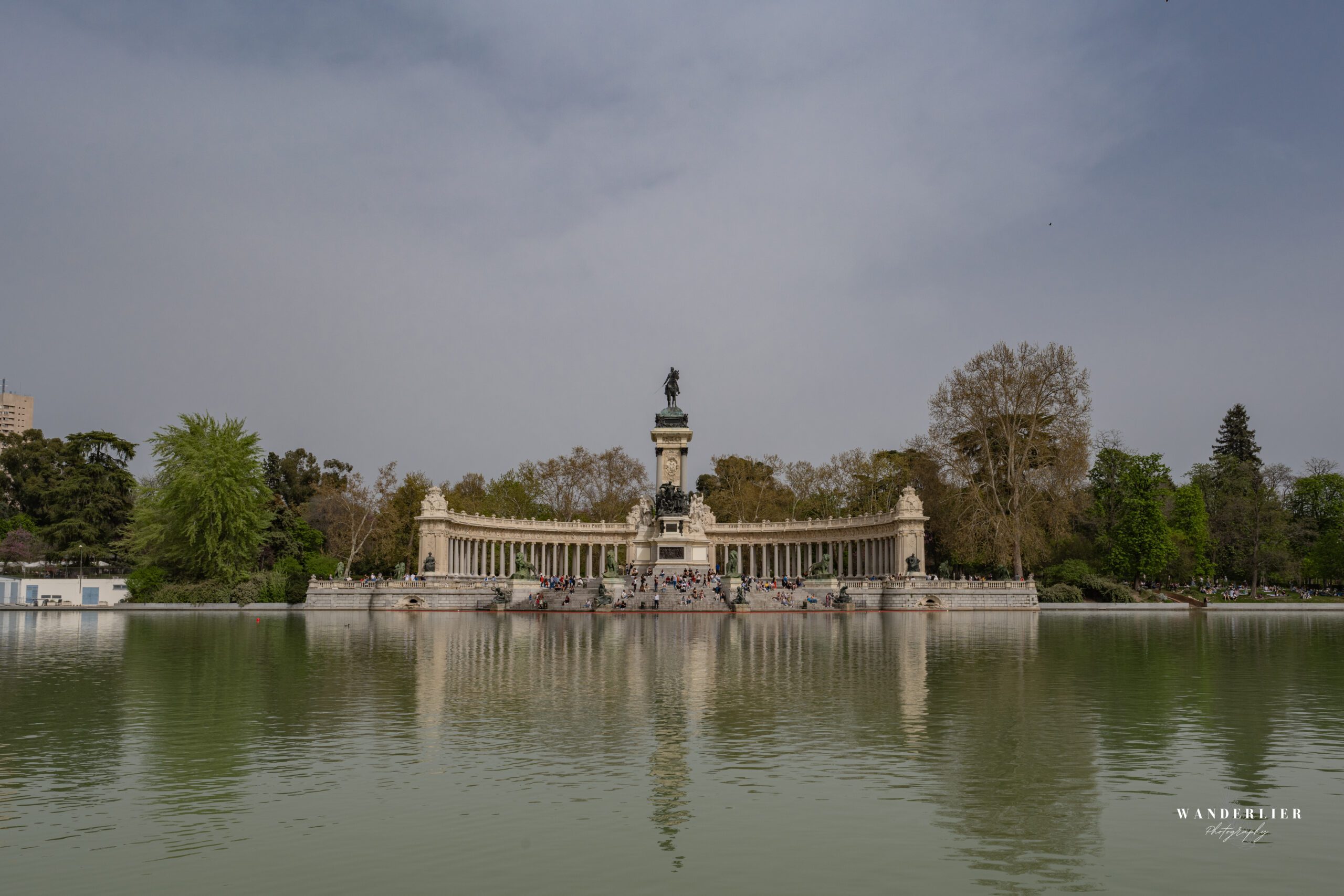
Palacio de Cibeles
The Palacio de Cibeles, also known as the City Hall of Madrid (Ayuntamiento de Madrid), is an iconic building located at Plaza de Cibeles, in the heart of the Spanish capital. This majestic structure, which combines neoclassical and baroque architectural styles, is not only an administrative center but also a cultural and architectural symbol of Madrid.
The Palacio de Cibeles was originally built as the main post office of Madrid and was completed in 1919. The design is the work of Spanish architect Antonio Palacios, who is known for his innovative and monumental designs. The building is constructed from white stone and is characterized by imposing domes, elegant columns, and detailed sculptures that highlight the grandeur of the structure.
One of the most striking features of the Palacio de Cibeles is its towering dome, which rises above the building. This dome, crowned with a bronze sculpture of the goddess Cibeles being drawn by lions, has become one of the most recognizable symbols of Madrid. The statue of Cibeles is a tribute to the Roman goddess of fertility, the earth, and agricultural abundance, and has grown to be one of the city’s most beloved icons.
In 2007, the Palacio de Cibeles underwent an extensive renovation and was transformed into the current City Hall of Madrid. In addition to administrative offices, the building now also houses exhibition spaces, conference rooms, and cultural institutions, including the Madrid Cultural Center (CentroCentro), which organizes a wide range of cultural events and exhibitions.
The Plaza de Cibeles, where the Palacio de Cibeles is located, is one of the most iconic squares in Madrid and serves as a meeting point and center of activity for both locals and tourists. The square is surrounded by other notable buildings, including the Palacio de Linares and the Palacio de Buenavista, and offers beautiful views of some of Madrid’s most distinctive landmarks.
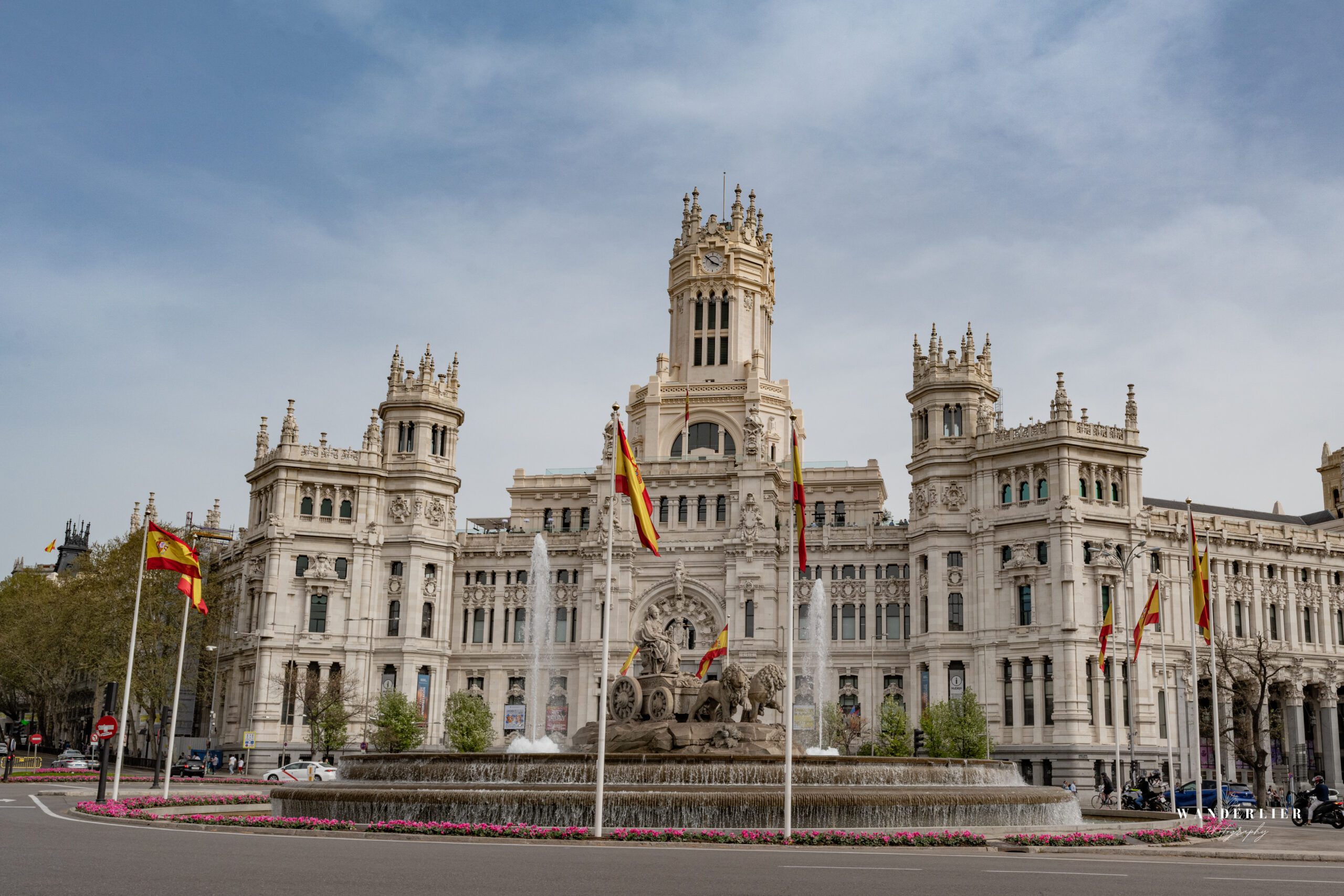
Palace of Madrid
The Palacio Real de Madrid is one of the most impressive and emblematic buildings in the Spanish capital. Located in the heart of Madrid, next to Plaza de Oriente, this majestic palace exudes grandeur and history, and serves as a symbol of the Spanish monarchy and cultural heritage.
The palace has a long and rich history dating back to the 9th century, when a Moorish fortress called the Alcázar stood on the site. However, the current palace was built in the 18th century after the original Alcázar was nearly completely destroyed by a fire in 1734. The palace was commissioned by King Philip V in an opulent Baroque style, resulting in one of the largest palaces in Europe, with more than 3,400 rooms.
The exterior of the Royal Palace is impressive, with its monumental façades, majestic domes, and elegant columns. It is surrounded by beautiful gardens, including the Campo del Moro and the Sabatini Gardens, which offer an oasis of tranquility amidst the hustle and bustle of the city.
Inside, the palace is equally impressive, with lavishly decorated rooms, grand salons, and extensive galleries. Visitors can admire the stunning Royal Chambers, featuring exquisite decorations, antique furniture, and precious artworks. Highlights include the Throne Room, the Gala Dining Room, and the Royal Pharmacy, all lavishly adorned with frescoes, crystal chandeliers, and gilded ornaments.
One of the most remarkable features of the Royal Palace is the Royal Chapel, which houses the Royal Pantheon. This is the final resting place of several Spanish monarchs, including Queen Maria Christina and King Alfonso XII.
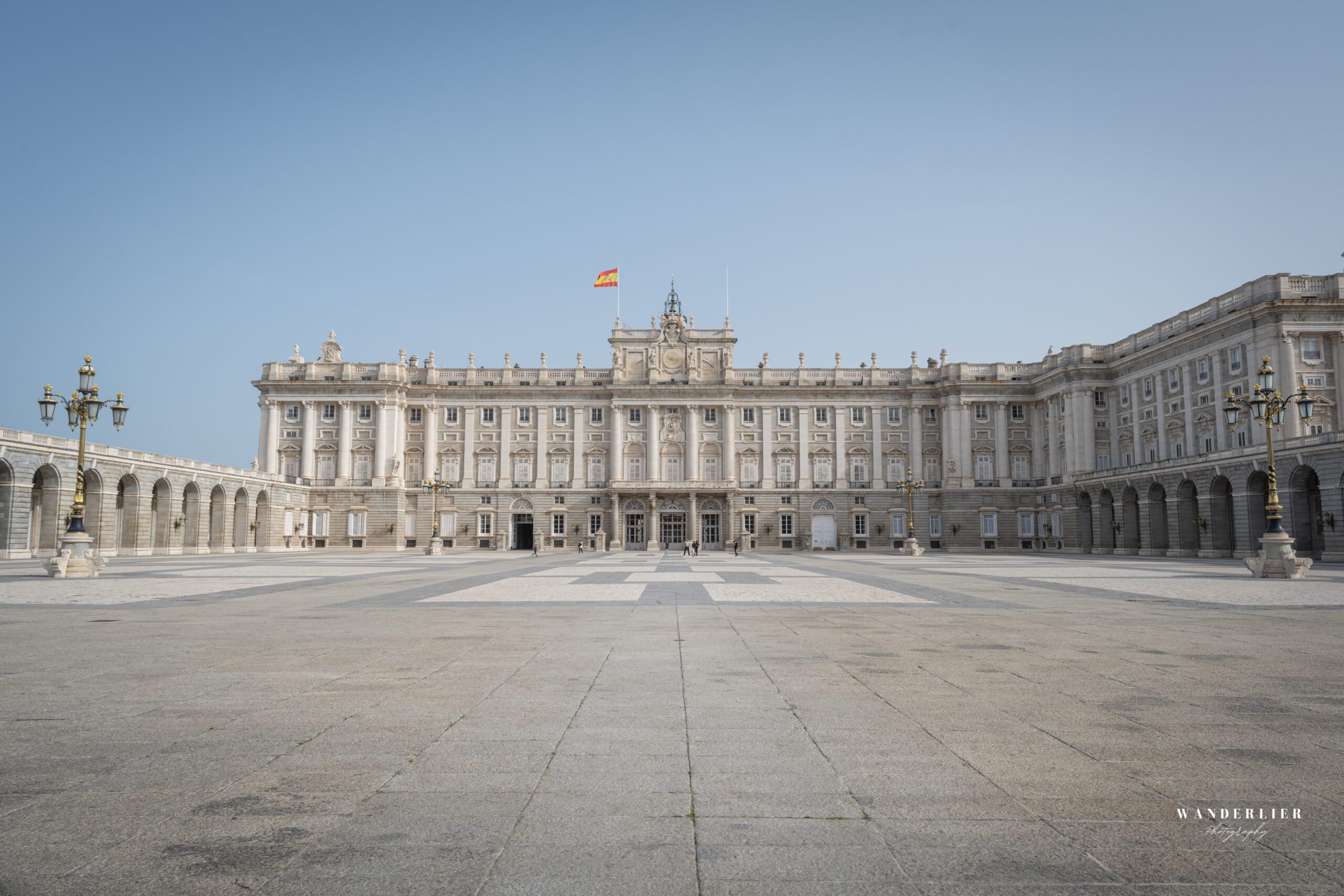
Almudena-Cathedral
Santa María la Real de La Almudena is a beautiful religious building that forms a striking addition to the skyline of Madrid. This cathedral, dedicated to the Virgin of Almudena, is not only an important place of worship but also an architectural masterpiece that embodies Spain’s rich history and cultural diversity.
Construction of the Almudena Cathedral began in the late 19th century, but due to various challenges and interruptions, it wasn’t completed until the end of the 20th century. The result is a unique blend of architectural styles, combining both neo-Gothic and neoclassical elements into a harmonious whole.
The façade of the Almudena Cathedral is impressive, with its towering spires, Gothic arches, and detailed sculptures that capture the attention of visitors. The interior of the cathedral is equally breathtaking, featuring stunning vaults, colorful stained-glass windows, and elaborate altarpieces that reflect the craftsmanship of the artisans who worked on it.
One of the most striking features of the Almudena Cathedral is the main altar, which is adorned with a magnificent altarpiece dedicated to the Virgin of Almudena. This altarpiece, along with other religious artworks and icons, attracts pilgrims and believers from around the world who come to offer their devotion and prayers to the Virgin.
In addition to its religious significance, the Almudena Cathedral is also a cultural and architectural symbol of Madrid. It serves as a popular tourist attraction and an important part of the city tours and walks offered through Madrid’s historic neighborhoods.
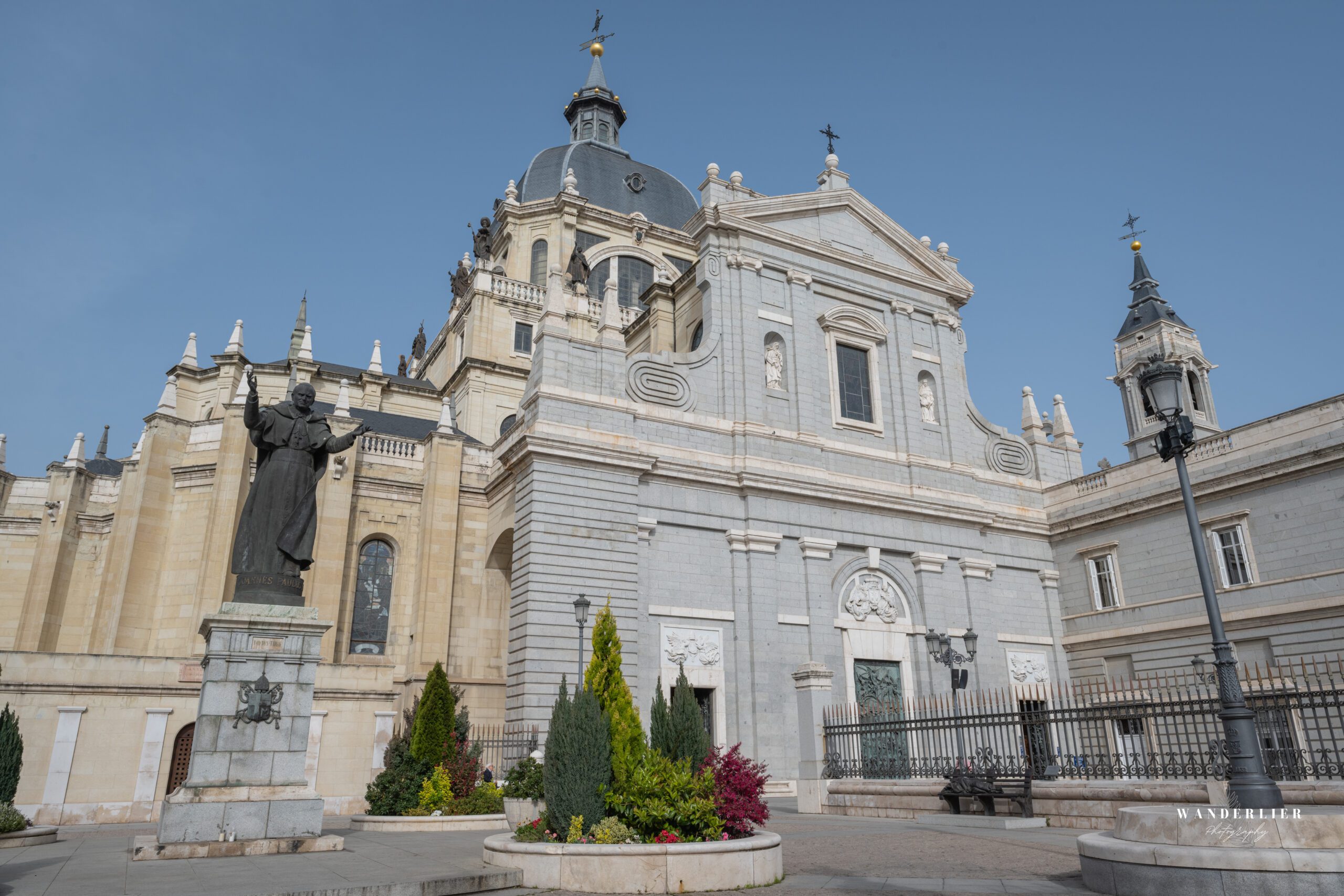
Plaza Mayor
The Plaza Mayor is one of the most iconic squares in Madrid and an essential part of the urban and cultural identity of the Spanish capital. Located in the heart of Madrid, in the Sol district, Plaza Mayor is a lively center of activity, history, and architectural grandeur, attracting visitors from all over the world.
The square was originally built in the 16th century, commissioned by King Philip II, and has since undergone several transformations. The current design of the Plaza Mayor dates back to the 17th century, when King Philip III ordered its reconstruction after a devastating fire. The square was designed by architect Juan Gómez de Mora and is characteristic of the Spanish Baroque style, with its rectangular shape, uniform architecture, and elegant arcades along the edges.
Plaza Mayor is known for its impressive dimensions and harmonious symmetry. It is surrounded by four-story buildings with red brick façades, interrupted by 237 balconies overlooking the square. The center of Plaza Mayor is dominated by a statue of King Philip III on horseback, proudly standing on an elevated platform, serving as a central point of orientation for visitors.
Over the centuries, the square has fulfilled many functions, serving as a location for markets, festivals, ceremonies, and even public executions. Today, Plaza Mayor primarily serves as a meeting place and a hub of commercial and cultural activities. Visitors can enjoy the many cafés, restaurants, and shops located along the arcades, and can take part in street performances, markets, and festivals regularly held in the square.
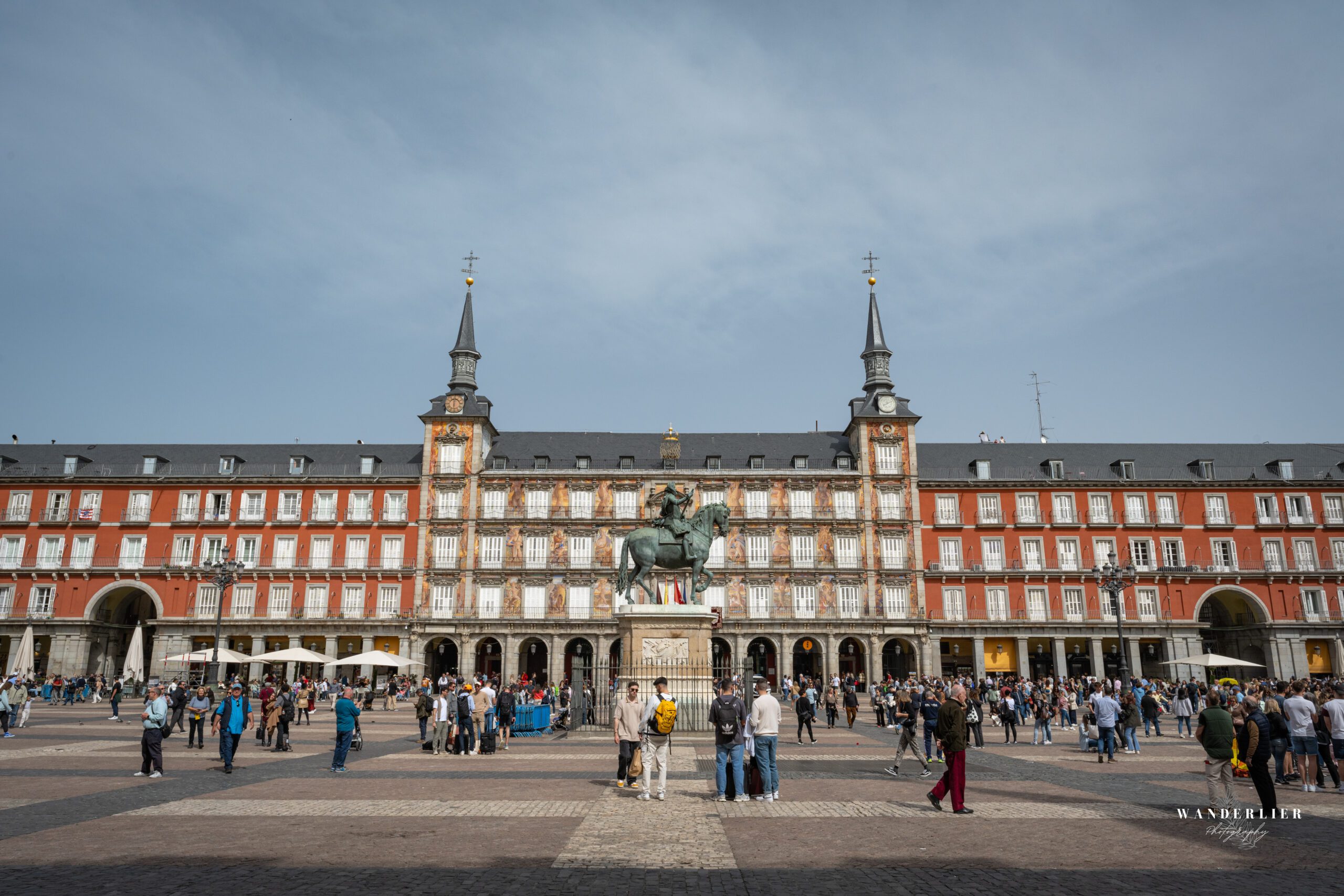
Edificio Metrópolis
The Edificio Metrópolis, or Metrópolis building, is one of the most iconic and recognizable landmarks of Madrid. Located at the intersection of Calle de Alcalá and Gran Vía, this stunning building has become a symbol of the vibrant streets and lively energy of the Spanish capital.
The Edificio Metrópolis was constructed between 1907 and 1911 on behalf of the Metrópolis Seguros insurance company, which is the origin of its name. The design of the building is the work of architects Jules and Raymond Février, who are responsible for the striking neobaroque and Belle Époque style that characterizes the structure.
One of the most prominent features of the Edificio Metrópolis is the impressive dome that crowns the building. This dome, adorned with golden details and decorated with statues and ornaments, immediately catches the eye of passersby and has become one of the most photographed and recognizable landmarks in Madrid.
The building itself is marked by its elegant façade, with rows of white columns, pilasters, and sculptures that reflect the beauty and grandeur of the Belle Époque era. The façade is adorned with statues representing allegorical figures, including personifications of Commerce, Agriculture, Industry, and Mining, which refer to the prosperity and progress of Spain at the beginning of the 20th century.
Over the years, the Edificio Metrópolis has undergone several transformations but remains an important architectural and cultural symbol of Madrid. It serves not only as office space but also as a landmark and meeting point for both locals and tourists.
The building’s location at the beginning of Gran Vía, one of Madrid’s main shopping streets, adds to its charm and allure. Visitors can enjoy the beautiful view of the building as they explore the bustling streets of the city, and can engage in shopping, dining, and sightseeing in the nearby areas.
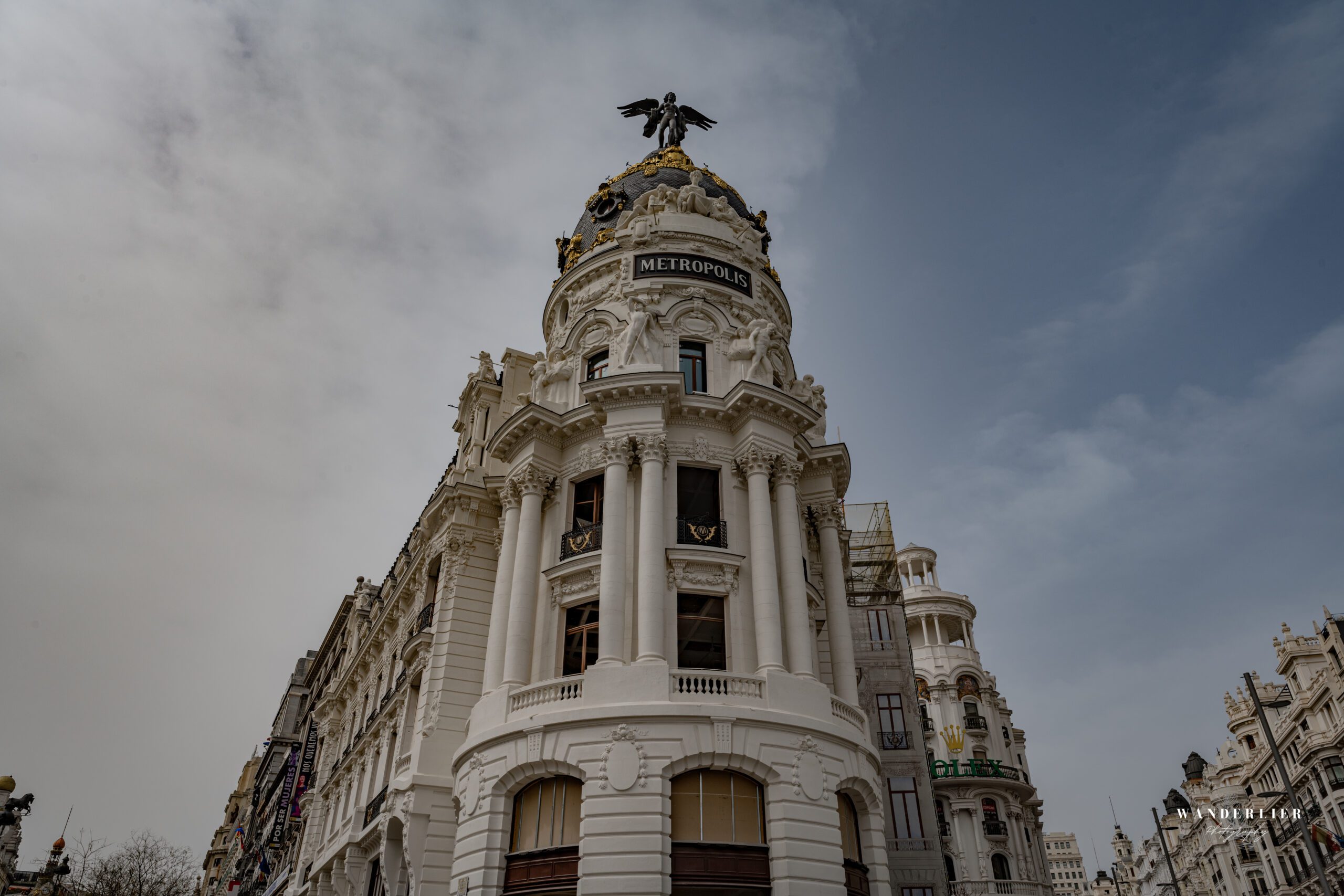
De Tempel van Debod
The Temple of Debod is one of the most intriguing and exotic monuments in Madrid. Located in the heart of the city, in the beautiful surroundings of the Parque del Oeste, this ancient Egyptian temple offers a fascinating glimpse into the distant history and culture of Egypt, right in the center of the Spanish capital.
The Temple of Debod was originally built in ancient Egypt in the 2nd century BC, dedicated to the goddess Isis and the god Amun. It was originally located on the banks of the Nile, south of Egypt, near the city of Aswan. However, in the 1960s, the temple was threatened by the construction of the Aswan Dam and was gifted to Spain in gratitude for its assistance in saving other archaeological treasures in the area.
The Temple of Debod was subsequently dismantled, transported to Madrid, and reconstructed in the Parque del Oeste, where it has stood as a striking landmark since 1972. It was carefully reconstructed, maintaining its original layout and features, including the beautiful reliefs that adorn the temple’s walls.
The Temple of Debod complex consists of several structures, including the main temple dedicated to Isis and a sanctuary dedicated to the god Amun. The temple is surrounded by water, creating a peaceful and serene atmosphere that invites visitors to relax and reflect.
One of the most spectacular aspects of the Temple of Debod is how it changes throughout the day and the seasons. At sunrise, the golden light bathes the temple in a warm glow, while at sunset, the pink and orange hues bring the stone walls to life. It is a magical experience to witness these transformations as the day progresses.
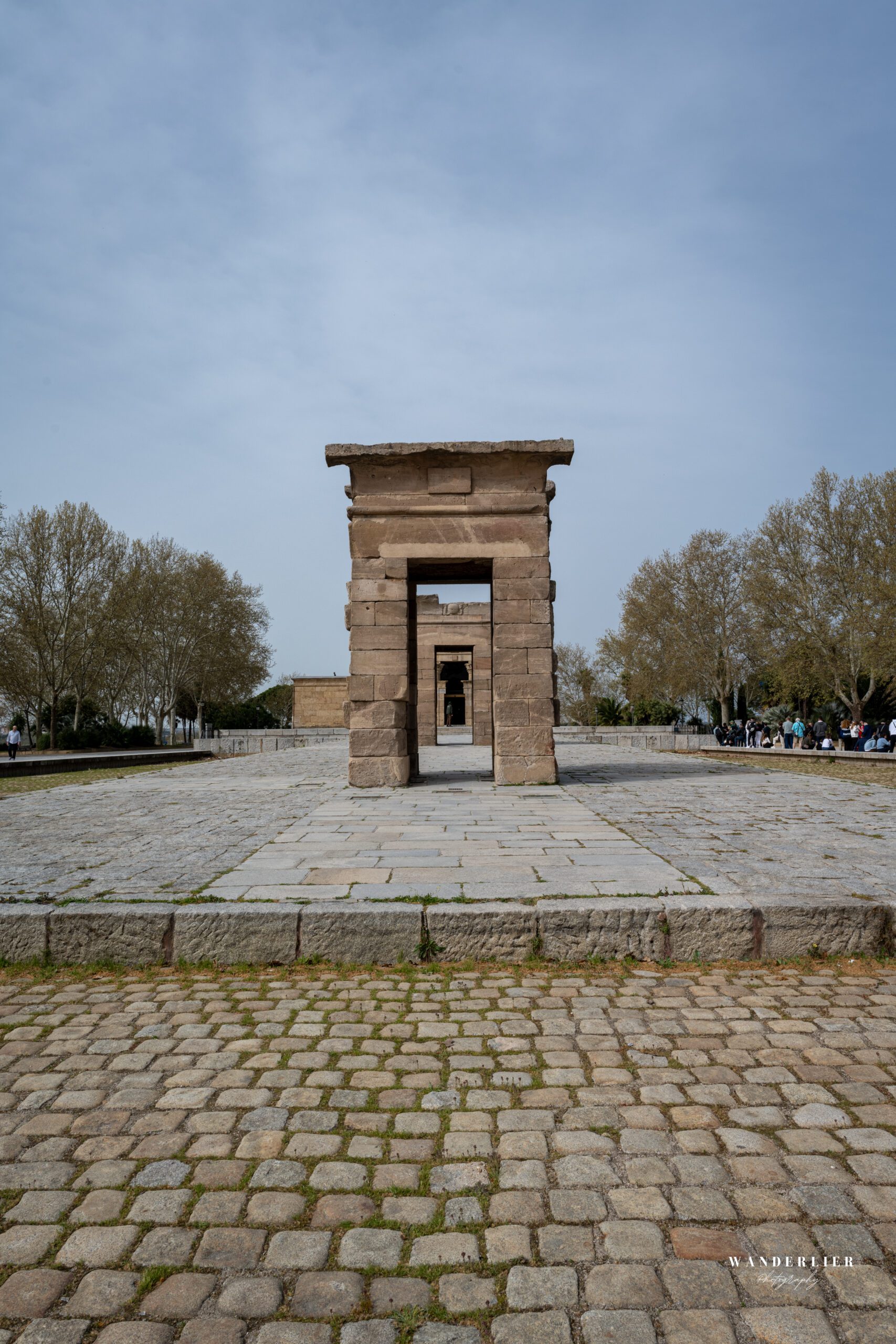
Plaza de España
The Plaza de España is one of the most impressive squares in Madrid and an important symbol of the city. Located in the center of Madrid, in the Argüelles district, this vast square serves as a lively hub of activity, history, and architectural grandeur.
The square was originally laid out in the early 20th century as part of a large-scale urban renewal project aimed at modernizing Madrid and transforming it into a contemporary capital. The Plaza de España was designed by architects Antonio Palacios and Joaquín Otamendi and was inaugurated in 1928 in honor of King Alfonso XIII.
One of the most striking features of the Plaza de España is the monumental statue dedicated to Miguel de Cervantes, the famous Spanish author of the masterpiece “Don Quixote.” The monument consists of a large statue of Cervantes, flanked by statues of his two most famous characters, Don Quixote and Sancho Panza. This iconic monument pays tribute to Spain’s literary heritage and is a beloved attraction for visitors from all over the world.
In addition to the monument to Miguel de Cervantes, the Plaza de España is dominated by two imposing buildings: the Edificio España and the Torre Madrid. These skyscrapers, standing on either side of the square, are among the most recognizable buildings in Madrid and are an integral part of the city’s skyline.
The square itself is a lively center of activity, with numerous benches, fountains, and green spaces where people gather to relax and enjoy the atmosphere. Visitors can stroll along the tree-lined promenade, take in the view of the Miguel de Cervantes monument, or simply unwind at one of the many cafés around the square.
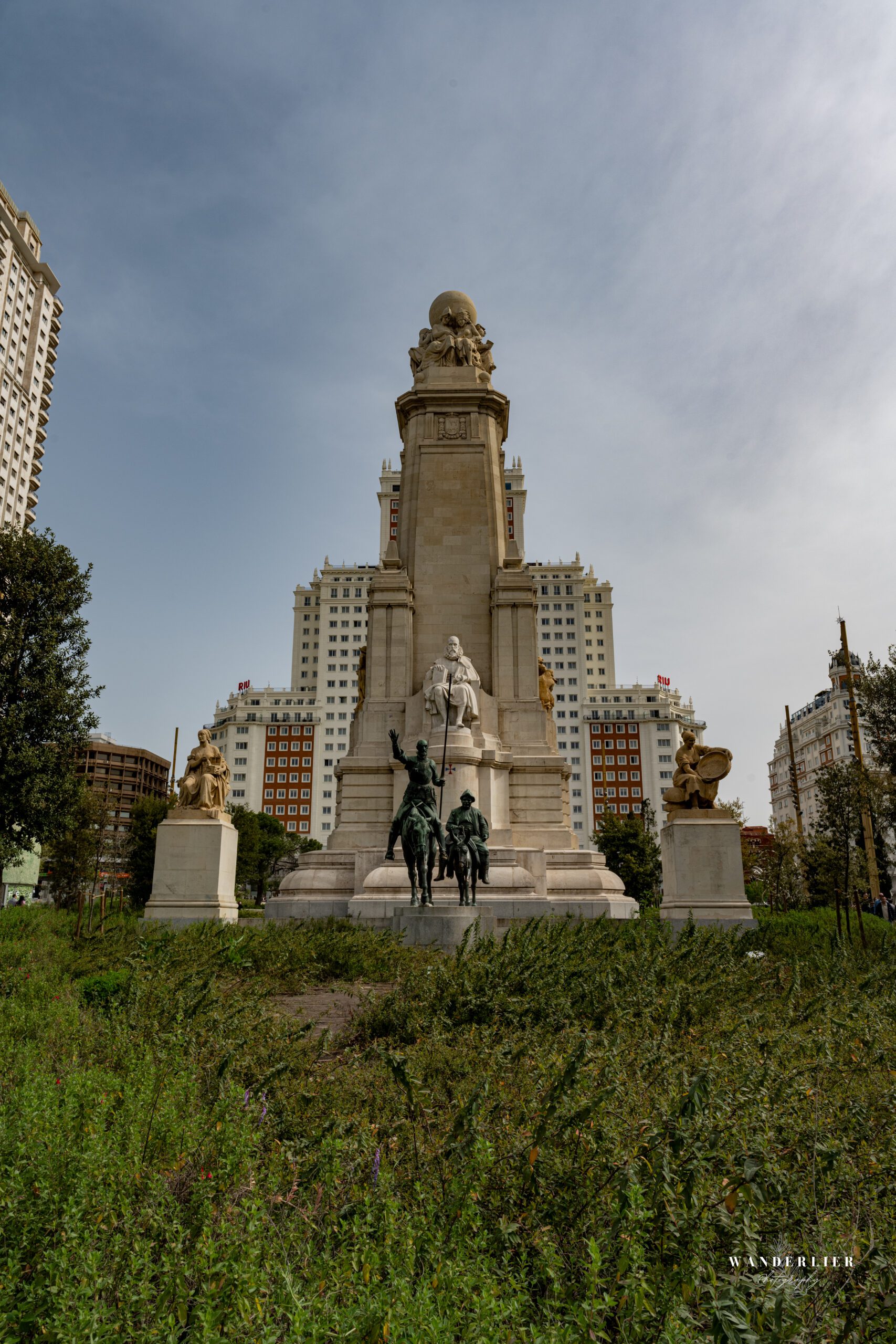
Museo del Prado
The Museo del Prado, located in Madrid, is one of the world’s foremost art museums and an absolute must-see for art lovers and culture enthusiasts. With its extensive collection of thousands of masterpieces from various eras and styles, the Prado Museum offers an unparalleled journey through the history of Western art.
The museum was founded in 1819 by King Ferdinand VII of Spain and opened its doors to the public in 1819. Its original goal was to create a national art collection that reflected Spain’s rich cultural heritage. Since then, the Prado Museum has grown into one of the most important art institutions in the world, with a collection that includes paintings, sculptures, drawings, and other artworks by some of the greatest masters in history.
One of the most notable features of the Prado Museum is its extensive collection of Spanish art, with works by renowned artists such as Francisco Goya, Diego Velázquez, El Greco, and Bartolomé Esteban Murillo. The collection encompasses a wide range of genres, including religious art, portraits, landscapes, and historical scenes, offering a deep insight into the development of Spanish art over the centuries.
In addition to Spanish art, the Prado Museum also houses an impressive collection of Italian, Flemish, Dutch, and German masterpieces. Here, you’ll find works by artists such as Titian, Rubens, Rembrandt, Bosch, Raphael, and Caravaggio, each of whom contributed to the evolution of Western art history in their own way.
One of the most iconic paintings in the Prado Museum’s collection is “Las Meninas” by Diego Velázquez, a masterpiece of Spanish Baroque art that is considered one of the greatest paintings of all time. Other highlights include Francisco Goya’s “The Third of May 1808,” Raphael’s “The Madonna of the Court,” and Hieronymus Bosch’s “The Garden of Earthly Delights.”
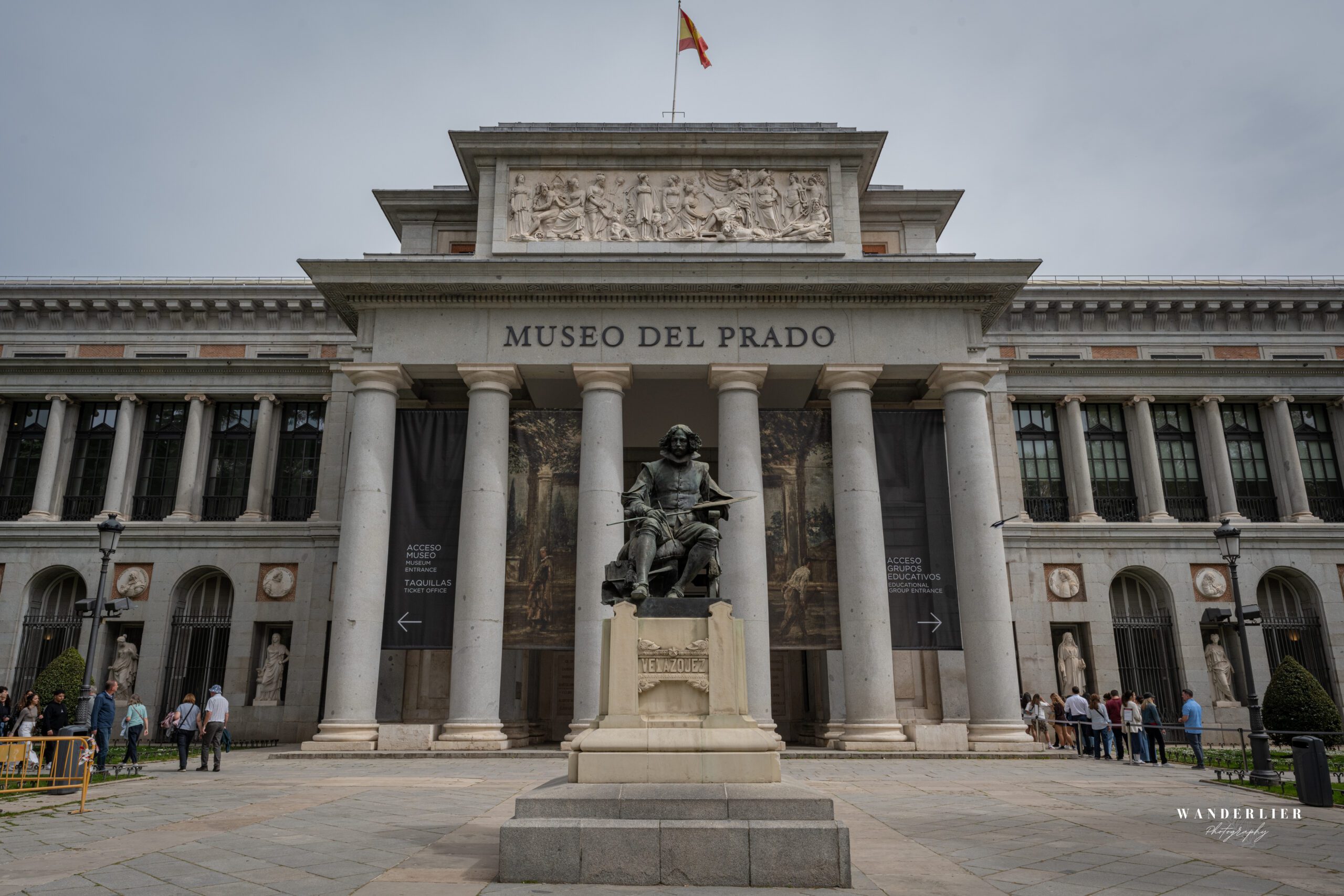
Palacio de Cristal
The Palacio de Cristal, or Crystal Palace, is one of the most enchanting and iconic monuments in Madrid, located within the beautiful Retiro Park. This stunning glass pavilion is not only an architectural masterpiece but also a symbol of the natural beauty and cultural wealth of the Spanish capital.
The Palacio de Cristal was built in 1887 as part of the Philippine Exhibition, which celebrated Spain’s rich colonial heritage. The pavilion’s design was the work of Spanish architect Ricardo Velázquez Bosco, who was inspired by the Crystal Palace in London. The result is a breathtaking combination of glass, iron, and stone, featuring an impressive dome and expansive glass walls that give the pavilion a light and airy feel.
Originally constructed as a greenhouse for exotic plants from the Philippines, the Palacio de Cristal quickly became a beloved venue for exhibitions, concerts, and other cultural events. Today, the pavilion primarily serves as an art gallery, hosting temporary exhibitions of contemporary art.
One of the most striking features of the Palacio de Cristal is its beautiful setting amidst the lush greenery of Retiro Park. The pavilion is surrounded by a large lake, creating an idyllic and picturesque view that captivates many visitors. The combination of the glass pavilion, the gently rippling water, and the abundant greenery creates a magical atmosphere that adds to the charm of the Palacio de Cristal.
The pavilion itself is also a work of art, with its elegant architecture and refined details that reflect the craftsmanship of its builders. The glass walls allow sunlight to flood the interior, bathing the displayed artworks in a warm glow and enhancing the beauty of the space.
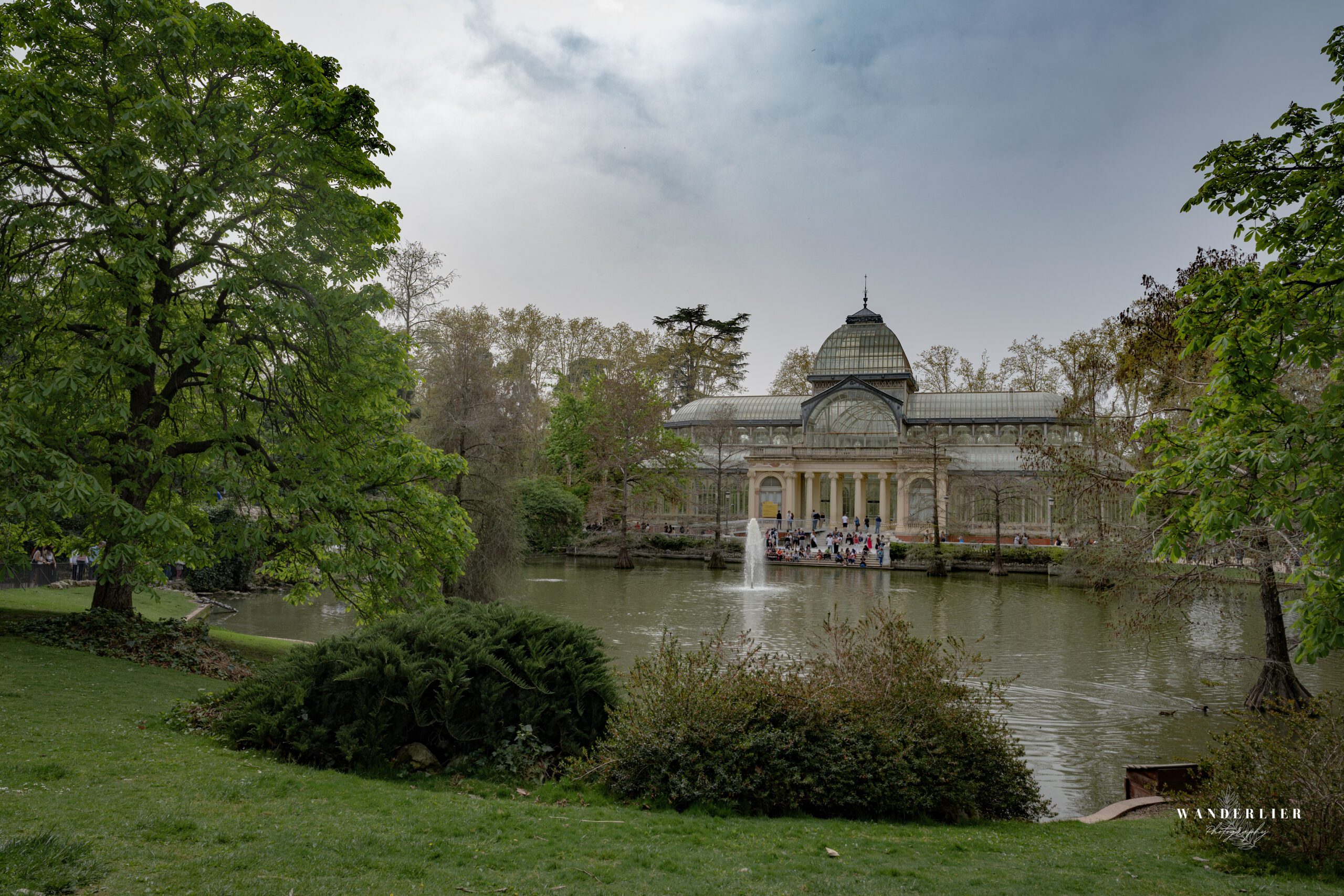
Monumento to Martinez Campos
The Monumento a Martínez Campos is a prominent statue dedicated to General Arsenio Martínez-Campos y Antón, a significant figure in Spanish history. It is located at the Plaza de la Lealtad in Madrid, an emblematic square adjacent to Parque del Retiro.
General Martínez-Campos played a crucial role in 19th-century Spanish politics and military history. He was a prominent figure during the restoration of the Spanish Bourbon monarchy and played a vital role in the signing of the Pact of Zanjón, which ended the Ten Years’ War in Cuba and led to reforms in Spain’s Caribbean colonies.
The monument, unveiled in 1907, was designed by the sculptor Mariano Benlliure, one of the most renowned artists of his time. The statue depicts General Martínez-Campos on horseback, in his distinctive military uniform, captured in a dynamic pose that symbolizes his determination and leadership. The figure stands on an imposing pedestal adorned with bas-reliefs representing scenes from the general’s life and career.
The Plaza de la Lealtad, where the monument stands, has a rich history and serves as an important cultural and political center in Madrid. The square is named after the loyal support that General Martínez-Campos received during his political and military career, and the statue serves as a tribute to his contributions to the Spanish nation.
The Monumento a Martínez Campos is not only an artistic masterpiece but also a significant historical symbol that commemorates the turbulent period in Spanish history during which it was erected. It stands as a monument to the political and military leaders who helped shape modern Spain, reminding us of the values of courage, loyalty, and patriotism embodied by General Martínez-Campos.
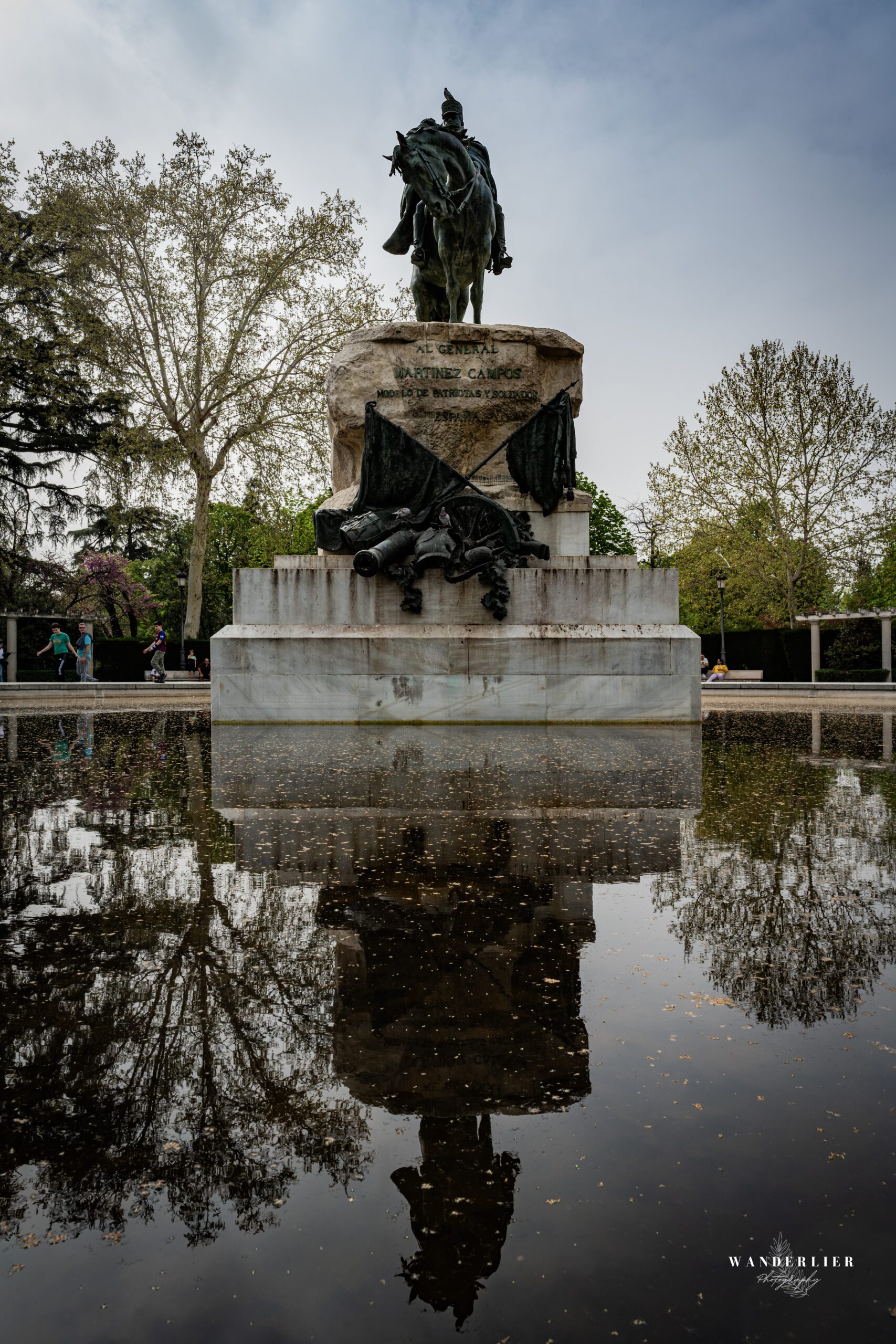
Puerta de Alcalá
The Puerta de Alcalá, literally translated as the Gate of Alcalá, is one of the most iconic monuments of Madrid and an important symbol of the city. Located at Plaza de la Independencia, at the eastern end of Calle de Alcalá, this imposing gate not only marks the entrance to the city but also the transition between old and new Madrid.
The history of the Puerta de Alcalá dates back to the 18th century when King Charles III of Spain commissioned its construction as part of a large-scale urban renewal project. The gate was designed by architect Francesco Sabatini and completed in 1778. It served as one of the five city gates providing access to Madrid and was a tribute to the king, who traveled from the nearby Alcalá de Henares to Madrid.
Architecturally, the Puerta de Alcalá is a masterpiece of neoclassical style, with its impressive dimensions, elegant columns, and detailed sculptures that embody the grandeur and magnificence of the Spanish monarchy. The monument is constructed from sandstone and limestone and is crowned by an impressive dome, flanked by four imposing columns on each side.
One of the most striking features of the Puerta de Alcalá is its symbolic significance for the city of Madrid and for Spain as a whole. It has served as the setting for numerous historical events and ceremonies, including royal processions, state funerals, and independence celebrations. It has also been immortalized in literature, art, and music as a symbol of Madrid’s cultural heritage and identity.
In addition to its historical and symbolic significance, the Puerta de Alcalá is also a popular tourist attraction and a beloved meeting place for both locals and visitors to Madrid. The surrounding Plaza de la Independencia is a bustling center of activity, with numerous cafés, restaurants, and shops where people gather to relax and enjoy the vibrant atmosphere of the city.
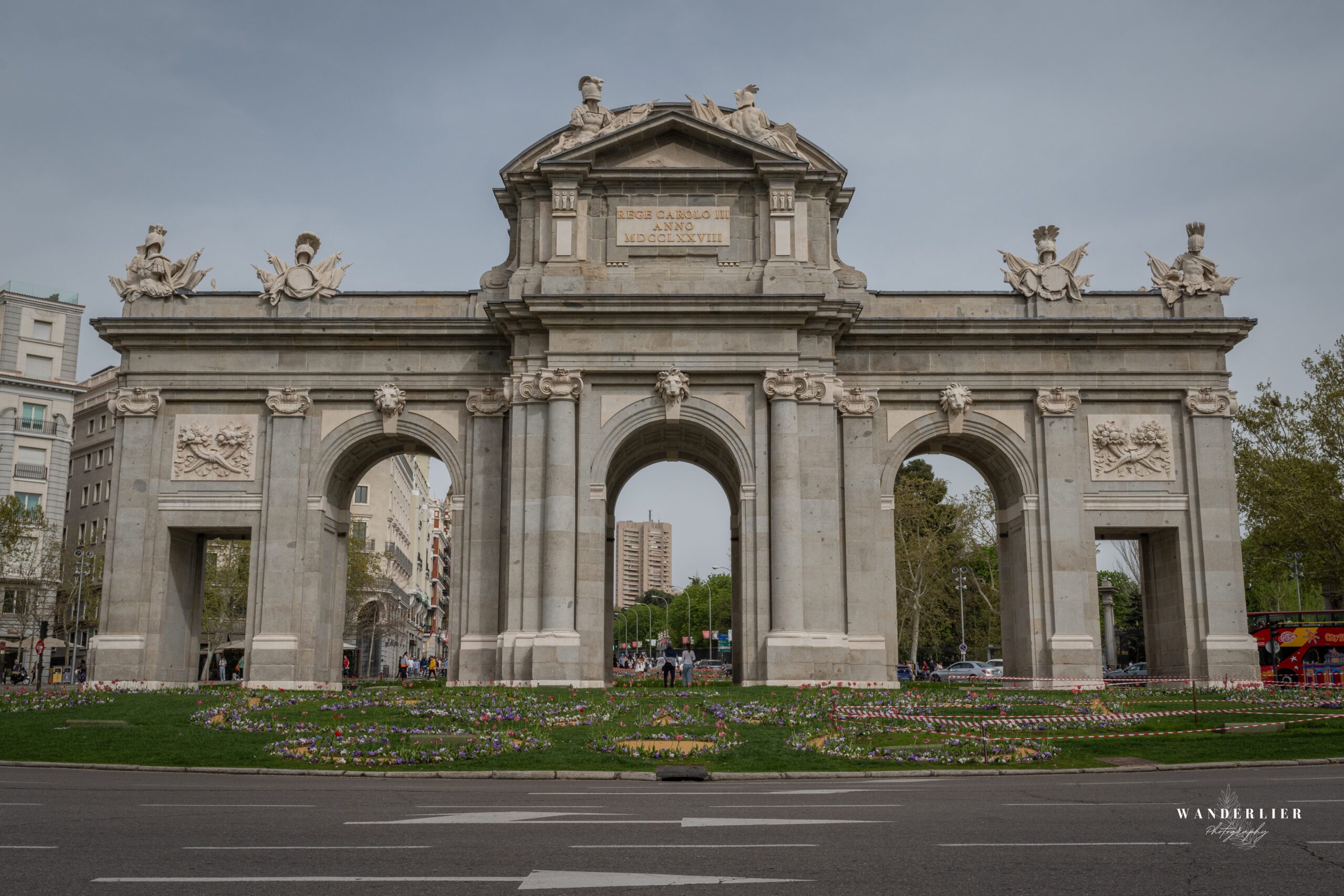
Parque del Buen Retiro
The Parque del Buen Retiro, often simply called Retiro, is one of the most beloved and iconic parks in Madrid and one of the largest green oases in the heart of the city. This vast park, covering over 125 hectares, is a popular destination for both locals and visitors of Madrid, who come to relax, exercise, walk, and enjoy the natural beauty and cultural richness of the park.
The history of Retiro dates back to the 17th century when it was created as the royal garden of the nearby Palacio del Buen Retiro. Over the centuries, the park has undergone several transformations, but it has always served as a cherished destination for relaxation and recreation for the residents of Madrid.
One of the most notable features of Retiro is the large artificial lake, the Estanque del Retiro, which stretches across the central part of the park. Here, visitors can take boat rides, enjoy the fountains and statues along the shore, or simply relax on a bench and enjoy the view of the water.
In addition to the lake, Retiro also houses many other attractions and landmarks, including the famous Rosaleda, a beautiful rose garden with thousands of blooming rose bushes, and the majestic Cristal Palace (Palacio de Cristal), a glass pavilion that serves as an art gallery and exhibition space.
The park is also known for its beautiful gardens, with winding paths, lush lawns, and colorful flowerbeds that bloom year-round. Visitors can walk, jog, cycle, or simply wander around and enjoy the peaceful and serene surroundings of the park.
In addition to its natural beauty, Retiro also has a rich cultural history, with numerous historical monuments, statues, and pavilions scattered throughout the grounds. One of the most notable monuments is the statue of King Alfonso XII, which proudly rises above the Estanque del Retiro and serves as a popular meeting point for both locals and tourists.
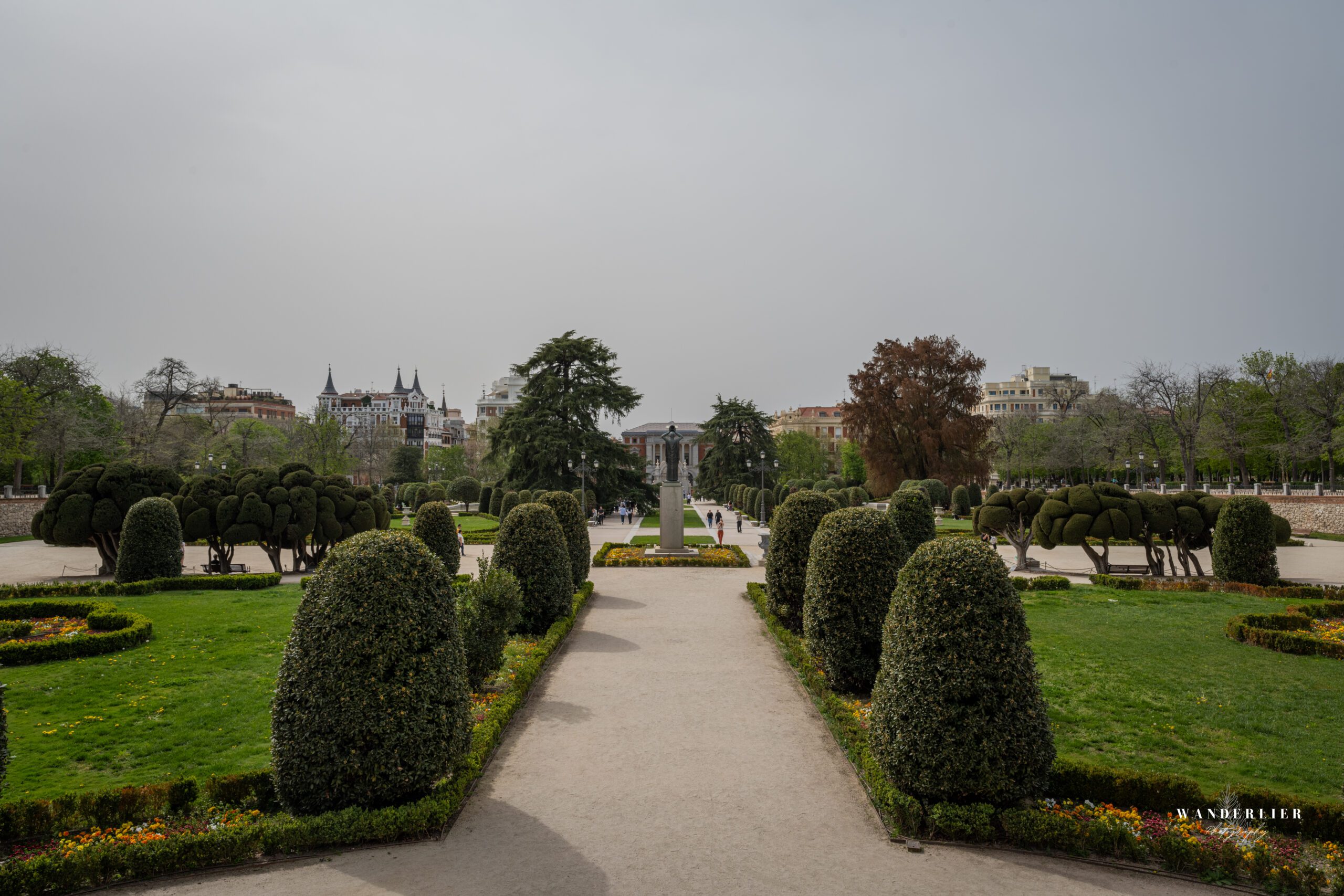
Estación de Cercanías de Atocha
The Estación de Cercanías de Atocha, or simply Atocha, is one of the most important train stations in Madrid and a crucial hub in the Spanish rail network. Located in the center of the city, near the Paseo del Prado and Retiro Park, Atocha is not only a major transportation hub but also a striking architectural landmark and a popular destination for both travelers and visitors to Madrid.
The original station was built in the second half of the 19th century but was later expanded and modernized to meet the growing demand for public transportation. The current station, inaugurated in 1992, is the result of an ambitious renovation project that transformed the station into a modern and functional transport hub.
One of the most striking features of Atocha is the impressive roof that spans the station, a masterpiece of modern architecture characterized by its glass and metal construction. The station was designed by Spanish architect Rafael Moneo and is considered one of the most remarkable architectural achievements in Madrid.
In addition to its architectural beauty, Atocha also houses a variety of other attractions and amenities, including shops, restaurants, cafés, and a botanical garden. One of the station’s most notable features is the beautiful tropical garden, which stretches across the central atrium and creates an oasis of calm and greenery in the heart of the busy station.
The station is also an important hub for regional train services in Madrid, with numerous train routes connecting the city to surrounding regions and cities. As a result, Atocha is not only a key transport hub for visitors to Madrid but also a crucial link in the local public transportation network.

